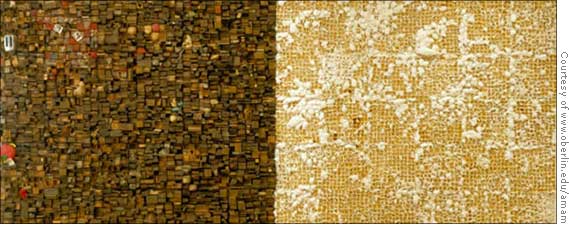
| << Front page | Arts | September 21, 2007 |
Student Lectures Initiated by Curator of Education Continue to Delight Members of Oberlin Community
The Sunday Object Talk
 |
|
| Decadent Decay: Leonardo Drew’s Untitled was the focus of junior Alexandra Sterman’s Sunday Obect Talk last week. | |
The Allen Memorial Art Museum is a treasure trove of cross-cultural visual history, a luminous, rich and decidedly underexposed collection of works spanning worlds ancient, modern and far between. Each Sunday afternoon at 2 p.m., the Allen invites the public to receive guided glimpses into these worlds. Led by a student docent, Sunday Object Talks offer brief, 15-minute, informal and yet enlightening discussion on a single work. It is an apt opportunity to delve deeper into the exhibited art than a casual visit might allow.
This past Sunday, College junior Alexandra Sterman spoke about Leonardo Drew’s Untitled (1999), a multimedia, three-dimensional, wall-mounted structure. The piece is part of the recently opened exhibit, Repeat Performances: Seriality and Systems Art Since 1960, in the Ellen Johnson Gallery.
Composed of cotton, wood, rust and a myriad of found objects, Drew’s structure is a showpiece of a dumpster diver extraordinaire and a powerful response to urban decay. Like Drew, Sterman finds splendor among the ruins. Before she began giving any background, she simply asked her audience, “What do you see? What materials are in front of you?” From the distinct toaster oven protruding out to the grid of cotton containers, she began by engaging the viewer to explore the work’s physical expressiveness.
“In a lot of ways, this is me getting other people to talk about art and to think about art,” Sterman said. As she approached the history of the artist and his composition, she figuratively broke apart a conceptually complex piece composed literally of multiple parts. She remained sensitive to the object’s visual texture, while also tapping into the cultural implications and human experience that it invokes. She explored the fusion of Western art history and African-American history, contemporary modernist culture and the legacy of slavery, which is inextricably intertwined with Drew’s art.
Additionally, she shared with us a detailed observation she recently made about the work; she pointed to an item incorporated into the structure that resembles a pincushion. On it, she noted, are scribbled the words “To Janet.”
“Who is Janet?” she wonders. “I don’t know. Drew probably didn’t either. But this object was once hers, and now it’s part of this whole piece.”
The Sunday Object Talks are the brainchild of the Allen’s Curator of Education Jason Trimmer. Relatively new to the museum staff, Trimmer initiated the series last February after teaching the Winter Term practicum in museum education. In preparation for giving tours and lectures, students become acquainted with the museum’s permanent collection and learn the basics about art education and tour-giving techniques.
Focused and brief, the talks were conceived with the goal of accessibility in mind. For the docent, the format of the talks works well and prompts the student to apply skills learned over Winter Term.
When researching Drew’s Untitled, Sterman “loved delving into one artist and one object. You don’t really get to do that on a tour. You have to keep moving. But this whole past week was spent with this one work.”
For the casual museum-goer wandering through the galleries, the wide and varying collection can be a lot to soak in. Still, sometimes “an hour-long tour would be too much. Having a docent present on a single object is a better way to inform the casual visitor,” Trimmer recognized.
A resident from Kendal who had listened in on Sterman’s talk remained seated on the bench facing the exhibit quite some minutes after the discussion was over.
“It just didn’t make any sense to me before. Looking at it now, it makes sense. I was feeling fortunate sitting here listening to her speak. It turned my mind around.”
Additionally, for the oft-returning museum visitor, the weekly talks put something on the calendar that “gives them a different perspective on ‘old favorites.’ For the first timer, it offers a level of engagement that they wouldn’t have had just walking around,” said Trimmer.
Sterman noted that students do not often walk casually into the museum. However, the brevity and casual nature of the object discussions hope to suit a perhaps slow Sunday afternoon, and aim to fit into students’ schedules.
“I think it’s especially great for Oberlin students. There’s not as much contact between the students and the museum as there should be. A lot more people from the community actually visit. Students don’t tend to wander in. But the [Object Talks] can get them to the museum. It’s sort of like drop-in hours. It’s really just 15 minutes, and you can get so much new information,” Sterman said.
About us
Subscriptions
Advertising